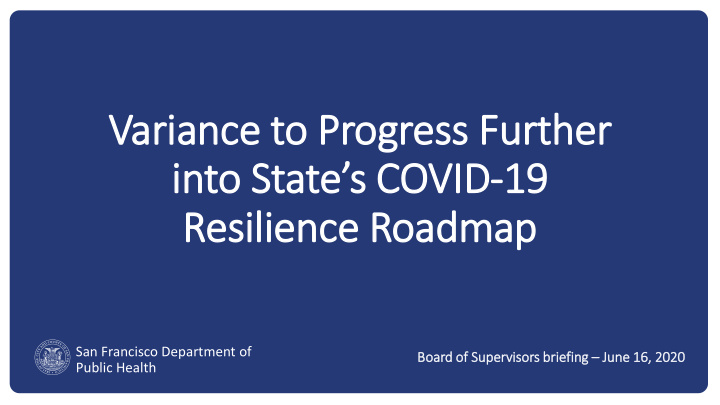



Variance to Progress Further into State’s COVID -19 19 Resilience Roadmap San Francisco Department of Bo Board of of Superv rvis isors brie riefing g – Ju June 16, , 2020 Public Health
The “New Normal” • Balance competing needs • Shared risk • “Safer” vs. “safe” • Cases will likely increase as shelter in place lifts • Key is to keep rate as slow and curve as flat as possible • Maintain/expand health system capacity • Uncertainty will persist • Resilience required, reversals possible • Equity lens in all decisions
What is is a variance? Allows counties to adopt aspects of Stage 2 of the state’s roadmap at a rate and in an order determined by the County Local Health Officer through submission of a written attestation to meeting the state’s readiness criteria to the California Department of Public Health (CDPH). San Francisco Department of Public Health
Why is is a varia iance im important? • Local decision-making and authority • Flexibility • Increased clarity on reopening pathway • Reopening driven by San Francisco data & metrics San Francisco Department of Public Health
Varia iance Readiness Crit iteria ia ✓ ✓ Epidemiologic stability of COVID-19 Vulnerable populations o o Demonstrated stable/decreasing number of patients hospitalized for Ongoing work with Skilled Nursing Facilities within the jurisdiction COVID-19 by a 7-day average of daily percent change in the total through a plan to prevent and mitigate COVID-19 infections in skilled number of hospitalized confirmed COVID-19 patients of <+5% -OR- no nursing facilities through regular consultation with CDPH district offices more than 20 total confirmed COVID-19 patients hospitalized on any and with leadership from each facility on the following: targeted testing single day over the past 14 days. and patient cohorting plans; infection control precautions; access to ✓ Protection of Stage 1 essential workers PPE; staffing shortage contingency plans; and facility communication o Clear guidance from the county for employers and essential critical plans. ✓ infrastructure workplaces on how to structure the physical environment Sectors and timelines o to protect essential workers. Provide details on which sectors and spaces will be opened, in what ✓ Testing capacity sequence, and on what timeline – for Stage 2 only. ✓ o Minimum daily testing capacity to test 1.5 per 1,000 residents, which Triggers for adjusting modifications o can be met through a combination of testing of symptomatic individuals Provide county metrics that would serve as triggers for either slowing and targeted surveillance. the pace through Stage 2 or tightening modifications, a plan for how the ✓ Containment capacity county will inform the state of emerging concerns and how it will o Contact tracing: At least 15 staff per 100,000 county population trained implement early containment measures. ✓ and available for contact tracing. COVID-19 Containment Plan o o Temporary housing units: Availability of temporary housing units to Testing o shelter at least 15% of county residents experiencing homelessness Contact Tracing ✓ o Hospital capacity Living and Working in Congregate Settings o o County (or regional) hospital capacity to accommodate COVID-19 Protecting the Vulnerable o positive patients at a volume of at a minimum surge of 35% of their Acute Care Surge o baseline average daily census across all acute care hospitals in a county. Essential Workers o Special Considerations o Community Engagement San Francisco Department of o Relationship to Surrounding Counties Public Health
Reopening San Francisco Current Roadmap: Phase 2c c – Tim Time: Ju July ly 13 Hair salons, indoor dining, and real estate open houses (if also allowed by the State) Businesses: • Hair salons and barber shops • Indoor dining • Real estate open houses with appointments only San Francisco Department of Public Health
Phase e 3 – La Larger Acti ctivit ities es – Tim ime: Augu gust and beyond Ma May inc nclu lude mo more th than 1 sub ub-phase Busin Businesses: • Hotels Ho ls, ho hospit itali lity, and and sho hort-term ren entals (i (if f al also o al allowed by y the the St State) • Gym yms and and fi fitn tness ce centers • Li Limit ited ind ndoo oor leis eisure like mo movie ie the theaters, bi billi liards, and and bo bowli wling g al alleys • Non Nonessentia ial l hea heali ling ar arts • Al All othe other per personal l ser ervic ices like indo ndoor or per person onal tr train inin ing, nail nail salon alons, tattoo oo, per permanent ma makeup, and and pi piercin ing g • Bars wi Bar without foo ood Ch Childcare and and edu education: • Pub ubli lic schoo ools ls, ac academic ic year ear begi begins (l (lear earnin ing g pl plans bein being g de develo loped by y SF SFUSD) • Oth Other schoo ools ls, inclu ncludin ing g pri primary, secon ondary, and and hi high gher edu educatio ion Cul Culture and and recreatio ion: • Indo ndoor or mus museums • Bas Basketball cou ourts • Playgrounds • Indo ndoor or and and ou outdoo oor swim wimmin ing g po pools ols • Indo ndoor or ten ennis is • Zoo oos San Francisco Department of Public Health
Next xt Steps • Board of Supervisors support letter • Submission to California Department of Public Health • Application considered accepted upon submission • San Francisco becomes variance county • Collaborative process to determine sequence and timing of next reopening phase for San Francisco San Francisco Department of Public Health
Questions? San Francisco Department of Public Health
Recommend
More recommend